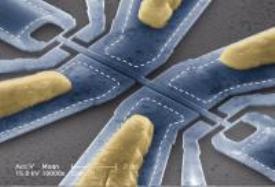A team with scientists from California Institute of Technology (Caltech) at the forefront has developed the first-ever mechanical device capable of weighing molecules one at a time.
 Molecule weighing device seen through a scanning electrn micrograph (Credit: Caltech / Scott Kelber and Michael Roukes)
Molecule weighing device seen through a scanning electrn micrograph (Credit: Caltech / Scott Kelber and Michael Roukes)
The new technology has great implications for disease diagnostics, study of cellular molecular machinery and study of viruses and may even lead to improved methods to measure nanoparticle pollution in air.
The device measures only two millionths of a meter and incorporates a minute bridge like structure that vibrates. The weight of a particle is determined from the change in frequency of vibration of the bridge by virtue of the particle mass when a particle lands on it. The mass of particles can thus be measured as and when it comes in. The device is based on a technique formulated by Caltech professor Michael Roukes and his colleagues over the last 12 years. The earlier version of the device was labeled the nanoelectromechanical system (NEMS) resonator which could measure mass of individual molecules. However, the drawback of this device was that the change in frequency of the bridge depended not just on the mass of the molecule but also on the location where it landed. The researchers had to take 500 measurements of the same particle to identify its mass as they could not identify the landing site.
The new device overcomes this limitation and requires just one molecule to measure the mass. Conventional molecule measurement technique called mass spectroscopy involves ionizing of millions of molecules which are then allowed to interact with electromagnetic fields. The mass of molecules are determined by analyzing the interactions. This technique is not suitable for heavier particles like viruses and proteins which do not get ionized easily and hence exhibit only a weaker interaction with electromagnetic fields. This makes it difficult to obtain accurate mass measurements. The new device can weigh even large particles. A major advantage of the device is that it can be mass produced using conventional semiconductor fabrication techniques.